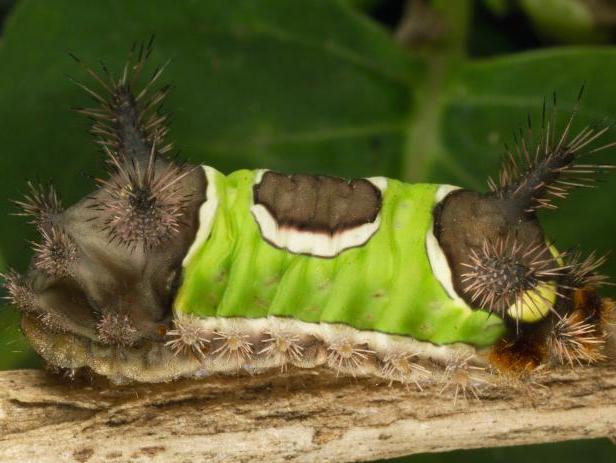Are Caterpillars Poisonous?

The Bottom Line
Many caterpillars have hairs or spines which are connected to poisonous glands. In contact with human skin, they can cause pain, itching, burning, swelling, and blistering.

Caterpillars cause a surprising number of stings for being such small creatures. While most caterpillars are harmless, there are several types of venomous caterpillars in the United States that can cause misery to humans who touch them. Among them are the saddleback, io moth, puss, gypsy moth, flannel moth, slug, spiny oak slug, and buck moth caterpillars.
Caterpillars feed on leaves as they grow from eggs, before they develop into pupa and finally into adult moths. Unintentional human contact occurs when people brush against caterpillars they don't see. That can easily happen in a yard or garden. It's especially hard for people who work in caterpillar-infested areas to avoid contact.
Do caterpillars bite?
Most problems from venomous caterpillar exposures are due to the tiny hairs (setae), spines, or quills on a caterpillar's body. These hairs or spines are connected to glands that produce a toxin. As part of the caterpillar’s defense strategy, when you touch these stinging hairs or spines, they can break off in your skin, releasing a tiny dose of that toxin in the process. Some cause allergic reactions. A few of these insects contain a toxin and can actually cause poisoning, though that is not common in the United States. For some caterpillars, their setae can blow on the breeze and land on skin, eyes, and clothing; this is common with gypsy moth caterpillars. From time to time, a young child will do what young children often do: pick up something interesting and try to eat it.
Are all fuzzy caterpillars poisonous?
As a general rule, brightly-colored caterpillars with spines, bristles, or a fuzzy appearance might be venomous and should not be touched. However, knowing what caterpillars to avoid touching may not be enough to prevent a sting. Preventing venomous caterpillar exposures can be difficult, as they often feed on the underside of leaves and can be difficult to see. Wearing a hat and gloves while gardening can help.
What does a caterpillar rash look like?
Symptoms of caterpillar stings occur when the stinging hairs or spines of a venomous caterpillar contact human skin. Pain, itching, and a rash are common. Blistering and swelling are possible. If setae blow into the eyes, eye irritation is expected. (Some caterpillars can cause more serious clinical effects; that's typically not expected from caterpillars in the United States.)
A history of caterpillar exposure makes diagnosis easy. If caterpillar contact isn't documented, the symptoms can look like a lot of other conditions. Symptoms of exposure to caterpillar venom may include skin redness, itching, swelling, welts, and blisters. Headache and nausea may also occur. More severe allergic reactions that involve shortness of breath and/or difficulty swallowing can develop if you touch your eyes or mouth after touching a poisonous caterpillar. Treatment involves removing the hairs or spines from the skin, then treating the symptoms.
Caterpillar sting treatment
To treat a rash caused by caterpillar stings:
- If the caterpillar is on the skin, remove it without using your hands!
- Gently put tape over the exposed area, sticky side down. (Any kind of tape will do.)
- Pull up the tape, removing the hairs or spines.
- Repeat with fresh pieces of tape as often as needed to treat the area involved.
- Wash the area gently with soap and water.
- If the area itches, put on a paste of baking soda and water.
- If that doesn't help, try a hydrocortisone cream.
- If that doesn't help, try an antihistamine cream. That shouldn’t be the first choice, as it doesn't always help. Also, some people have skin reactions to these creams.
- If the area is badly blistered, contact your health provider.
- Call your health provider about a tetanus booster if your shots are not up to date.
What to do if you are stung by a caterpillar
If you or someone else is stung by a caterpillar, call Poison Control at 1-800-222-1222 or use the webPOISONCONTROL® online tool for treatment guidance. Both services (phone and online guidance) are free, confidential, and available 24 hours a day.
Kelly Johnson-Arbor, MD
Medical Toxicologist
Rose Ann Gould Soloway, RN, BSN, MSEd, DABAT emerita
Clinical Toxicologist
Poisoned?
Call 1-800-222-1222 or
Prevention Tips
- When possible, avoid areas infested with caterpillars.
- Wear a hat and gloves while gardening.
- If a caterpillar is stuck to the skin, remove it with a stick or tool. Do not touch it with bare hands.
- Teach children to leave caterpillars alone!
This Really Happened
Case 1: A woman brushed her pinky finger against a saddleback caterpillar. She had a lot of redness, blistering, and pain, with a burning sensation that extended into her forearm. She tried ice, baking soda paste, hydrocortisone ointment, other skin creams, and oral antihistamines. Nothing provided relief. Several hours later, she called Poison Control and was advised to put some tape onto her finger, sticky side down, then pull up on the tape. She did so and pulled the tiny caterpillar hairs out of her skin. The burning went away soon after and the pain decreased. She was able to treat the remaining redness and blistering with an ointment containing hydrocortisone and an antibiotic.
Case 2: At school, a teenager put his hand onto a stair rail; he didn't see the puss caterpillar there on the railing. The sting area was red and painful. The student applied tape to remove the tiny hairs. He washed the area, used a hydrocortisone cream on the site, and took diphenhydramine (an antihistamine). His pain and redness went away quickly. By the next day, his hand looked normal.
For More Information
Photos of more stinging caterpillars (University of Kentucky College of Agriculture Cooperative Extension Service)
Spring Poisoning Prevention Tips
True Stories for Springtime: Avoiding Poisons and Outdoor Hazards
References
Caterpillars: MedlinePlus Medical Encyclopedia
Claudet I, Maréchal C. A transatlantic caterpillar. Pediatr Emer Care. 2009;25:186-187.
Paraska KK. Caterpillar stings – a case study. AAOHN J. 2009;57:402-403.
Poisoned?
Call 1-800-222-1222 or
Prevention Tips
- When possible, avoid areas infested with caterpillars.
- Wear a hat and gloves while gardening.
- If a caterpillar is stuck to the skin, remove it with a stick or tool. Do not touch it with bare hands.
- Teach children to leave caterpillars alone!
This Really Happened
Case 1: A woman brushed her pinky finger against a saddleback caterpillar. She had a lot of redness, blistering, and pain, with a burning sensation that extended into her forearm. She tried ice, baking soda paste, hydrocortisone ointment, other skin creams, and oral antihistamines. Nothing provided relief. Several hours later, she called Poison Control and was advised to put some tape onto her finger, sticky side down, then pull up on the tape. She did so and pulled the tiny caterpillar hairs out of her skin. The burning went away soon after and the pain decreased. She was able to treat the remaining redness and blistering with an ointment containing hydrocortisone and an antibiotic.
Case 2: At school, a teenager put his hand onto a stair rail; he didn't see the puss caterpillar there on the railing. The sting area was red and painful. The student applied tape to remove the tiny hairs. He washed the area, used a hydrocortisone cream on the site, and took diphenhydramine (an antihistamine). His pain and redness went away quickly. By the next day, his hand looked normal.
